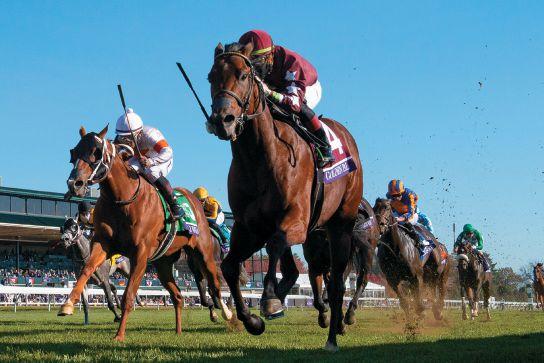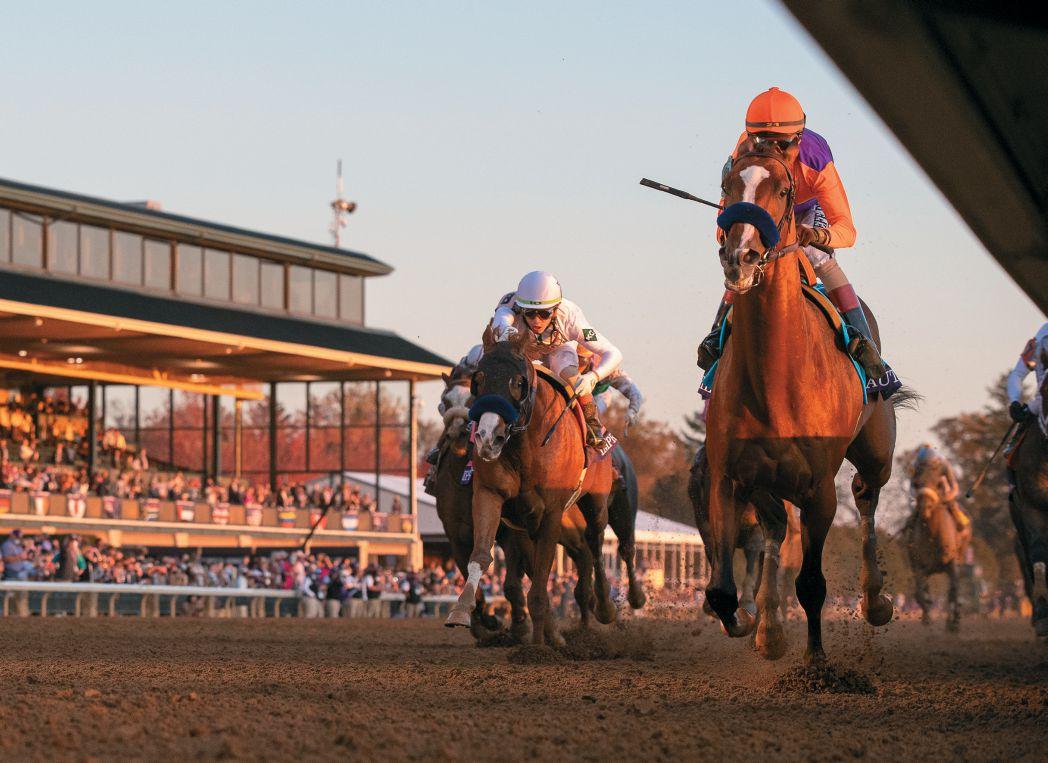
16 minute read
Winners
A horse’s hocks are one of its most injury-prone joints because of the high-speed activities the horse is often required to perform

HOCK INJURIES HOCK INJURIES
DEALING WITH A FREQUENTLY OCCURRING PROBLEM
BY HEATHER SMITH THOMAS
The hock is one of the largest, most complex, and hardest-worked joints in the horse’s body, so it must be strong and sturdy to avoid injury. T e hock is often under great stress because of the activities we ask the horse to do, and it might be injured during high-speed performance.
T e hock is similar to the human ankle, with the same seven bones.
Dr. Jillian Mills, of Presidio Equine Sports Medicine & Rehabilitation in Encinitas, Calif., says hock injuries are interesting because this joint is a combination of high- and low-motion joints.
“T ese joints can undergo dif erent pathological changes that can lead to clinically relevant disease,” Mills explained.
“A lot of times with hocks we will see acute traumatic injuries, DOD (developmental orthopedic disease), or fatigue-related injuries. Acute injuries often involve fractures, which may include the tibia and cannon bones, as well as collateral and intra-articular ligament injuries.
“T e upper joint (the high-motion joint) more often has developmental issues such as OCD fragments and subchondral bone cystic lesions. If there is an OCD fragment, the horse may need surgery to have the fragment removed. However, this is not always the case.
“We know that the joint environment is not as healthy as it would be if an OCD lesion was not present. On a
pre-purchase exam, it may be difcult to determine whether the osteochondral fragments will need to be removed surgically. For a young horse that hasn’t had the opportunity to prove itself, if we fnd an osteochondral fragment in a joint that carries excess fuid, where the horse trots of lame following fexion testing, there’s a higher probability that it will need surgery to remove that chip. Te presence of the OCD fragment is an indication that the joint is less healthy, and the horse is more prone to developing arthritis.”
By contrast, if the horse is 10 years old and has already proved itself at the buyer’s prospective level of competition, the OCD lesion on a pre-purchase exam might not be an issue.
“With racehorses, however, we are generally dealing with a signifcantly younger population of horses with a shorter prospective career,” said Mills. “So surgery is often recommended.
“Fatigue-related problems might include subchondral bone disease and breakdown of the joint’s cartilage. When that happens, we have to manage these horses for arthritis. We sometimes see arthritis in the upper joint, but this is signifcantly less common than in the lower joints and often results in debilitating lameness. Usually, when we’re talking about fatigue-related injuries in the hock, we are dealing with arthritis in the lower hock joints rather than the upper joint.”
If there are changes in the upper joint, these clinical signs generally include a signifcant increase in joint fuid, which can be seen as a pronounced swelling.
“If there is an osteochondral fragment in there, there is often joint swelling and the horse may show positive to fexion testing,” said Mills. “However, when a horse reacts positively to hock fexion, this is not a specifc fnding. Pain could be originating from any of the joints.
“With the lower joints, sometimes we can palpate thickening of the joint capsule. But you cannot palpably determine an increase in joint fuid. It’s more of a clinical assessment, especially if we are not doing blocks.
COURTESY OF JILLIAN MILLS
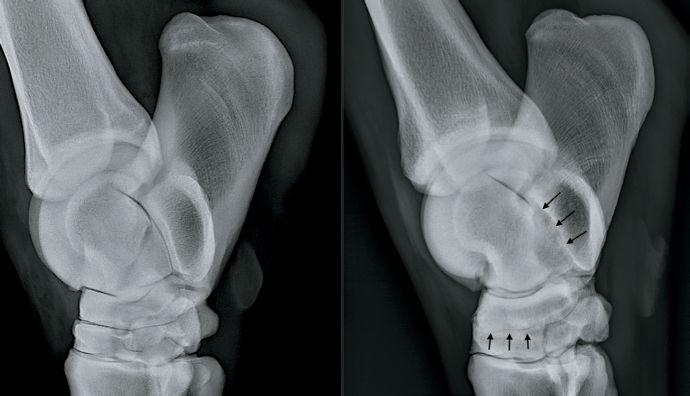
Radiographs are used to reveal problems in the joints of horses, for example, ankylosis in the lower hock
— Dr. Jillian Mills
“In cases of underperformance, we might look at a horse and see that it is a little bit short-strided in both hind limbs and a bit worse on the inside versus the outside of a circle, and positive to fexion. We might have a discussion with the owner about medicating the joint as a diagnostic therapeutic, which is essentially a treatment trial to see if the horse improves.
“Bilateral hind-limb asymmetry is most common in an arthritis type of presentation versus something acute, where you might detect pronounced
COURTESY OF DUNCAN PETERS
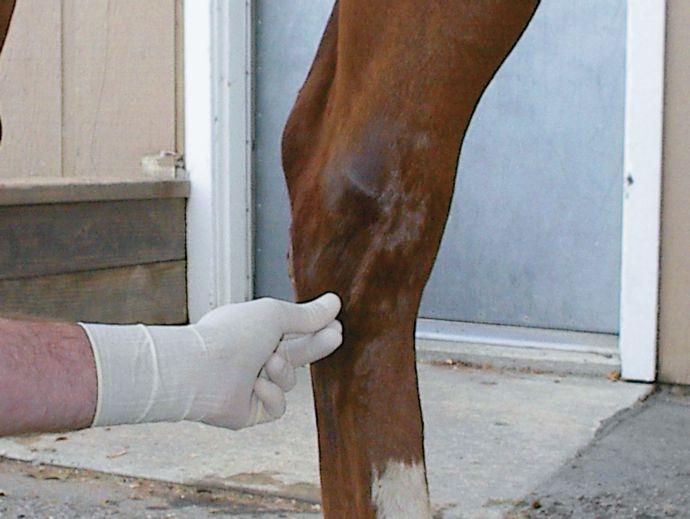
soft-tissue swelling in the joint. In those situations, we often see a unilateral lameness, meaning only one limb is afected.
“Between the talus and the calcaneus, within the high-motion tarsocrural joint, there is another articulation called the talocalcaneal joint. Tis is a low-motion articulation that can also develop arthritis. When this occurs, the pain can be quite debilitating and extremely difcult to manage. But this is also relatively rare.”
Dr. Duncan Peters, DVM, of EastWest Equine Sports Medicine in Lexington, Ky., says we often see hock soreness in athletic horses due to strain and stress.
“In young horses (weanlings and yearlings), we may see OCD or bone cysts in the hock joints,” Peters said. “Tese defects are usually discovered early on, and many are taken care of surgically. Occasionally, some of those are not evident until the young horse starts training and then gets a small osteochondral fragment (usually in the tibial tarsal joint) and associated swelling and lameness within the joint.
“Most of those chips in the joint will occur early in training or when they start racing. Te horse has to stop training and have the chip removed surgically. Some of those horses can get back to work and training within 90 days or so and don’t miss very much time.”
If the problem is discovered early and taken care of, the outcome is usually good.
“More commonly, the hock problems we see in young horses are just a sore-
Shock wave therapy is an emerging modality for treating hock injuries
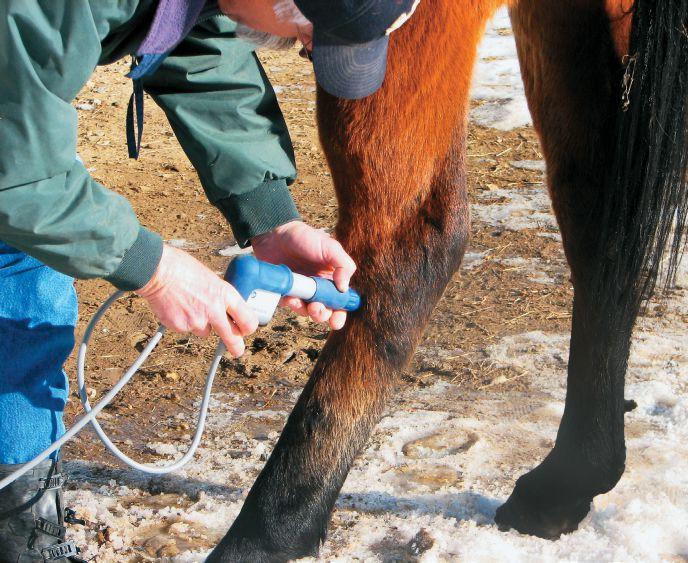
COURTESY OF DR. BRUCE CONNALLY
ness,” said Peters. “As the horse starts working and being asked to do more, the hock joints get sore, just because of the mechanics of that area of the leg. Te hock is unique because the upper joint is a high-motion joint and the lower joints are low-motion but must endure a lot of concussion. Tose lower joints are held together with many small ligaments—holding those two rows of small bones together.”
If there is too much strain on the hock, infammation can occur in the ligaments holding those small bones together, as well as infammation within the joint itself—which causes synovitis in the joint.
“Depending on what we fnd, it may require a diferent course of treatment,” said Peters.
Some of these horses will sufer bone bruising and bone soreness.
Synovitis and bone trauma can lead to arthritis in those lower joints.
“Tis can progress and become serious if not taken care of early on,” said Peters. “Usually, we will use some injections in those joints (steroids, hyaluronic acid, IRAP, stem cells, platelet rich plasma, amnionic fuid isolates, etc.) in an efort to reduce the infammation and curb the development of arthritis. We’ll also back of on the exercise and training for a while.
“If there is bone soreness and trauma—perhaps some micro-fractures associated with the bone bruising—it may take four to six months before the horse can go back to work. Racehorse people don’t like to miss that much time in training/racing.
Several of these problems can show up with similar signs, but might need a completely diferent course of treatment and a diferent length of time of, in terms of how they respond.
“Another thing that’s interesting about the hock is that there is sometimes some involvement with the proximal suspensory ligament,” said Peters. “Tere may be some pain-causing damage to that ligament where it originates at the back of the hock. Tis may actually be the primary problem that leads to secondary hock problems. We fnd this on MRIs more than with any other type of diagnostic tool.
“Tese horses won’t be performing well. Tey will have a soft-tissue problem related to the origin of the suspen-
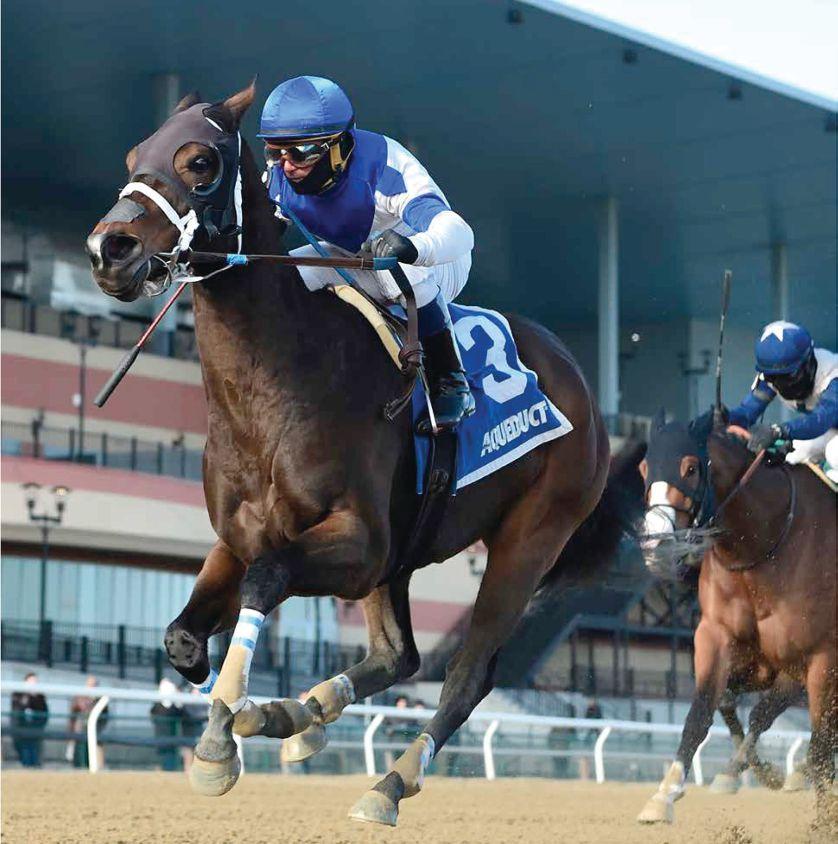
develop talent that lasts! We offer a training program with an understanding of what it takes during the early stages of a young horse that get results whether you want them to be prepared (1) to race, (2) to point for an auction to sell, or (3) to race and sell at the racetrack.
We broke and prepared such top California-breds to race or sell as graded stakes winners SPICED PERFECTION (G1), BROTHER DEREK (G1), RIVERS PRAYER (G1), COVER GAL (G2), GERVINHO (G2), SOLID WAGER (G3) and SHADOW OF ILLINOIS (G3), as well as recent California two-year-old champions CALIFORNIA DIAMOND and CRUEL INTENTION.
In 2020 alone, our program has produced at least 8 two-yearold stakes horses. Two-year-olds we prepared won the four out of frst fve races at Santa Anita. We then continued to do extremely well at Del Mar winning the Graduation Stakes with POSITIVITY, after winning the same race in 2019 with BIG RETURNS, and the Del Mar Futurity (G1) with DR SCHIVEL.
Since Luis Mendez started training at racetracks in California two years ago, he has trained until the end of summer and then
John BROCKLEBANK LUis MENDEZ Breaking & Training red cliffs racing, inc
sent horses on to other trainers. These horses include future stakes winners CAROTARI, OLIVER and RAGING WHISKEY.
We broke, prepared and trained a horse that sold for $170,000 at the 2020 OBS March Two-Year-Old Sale and have already sold THREE two-year-olds for more than that amount to date this year that were raced and sold out of the Luis Mendez training barn in Southern California.
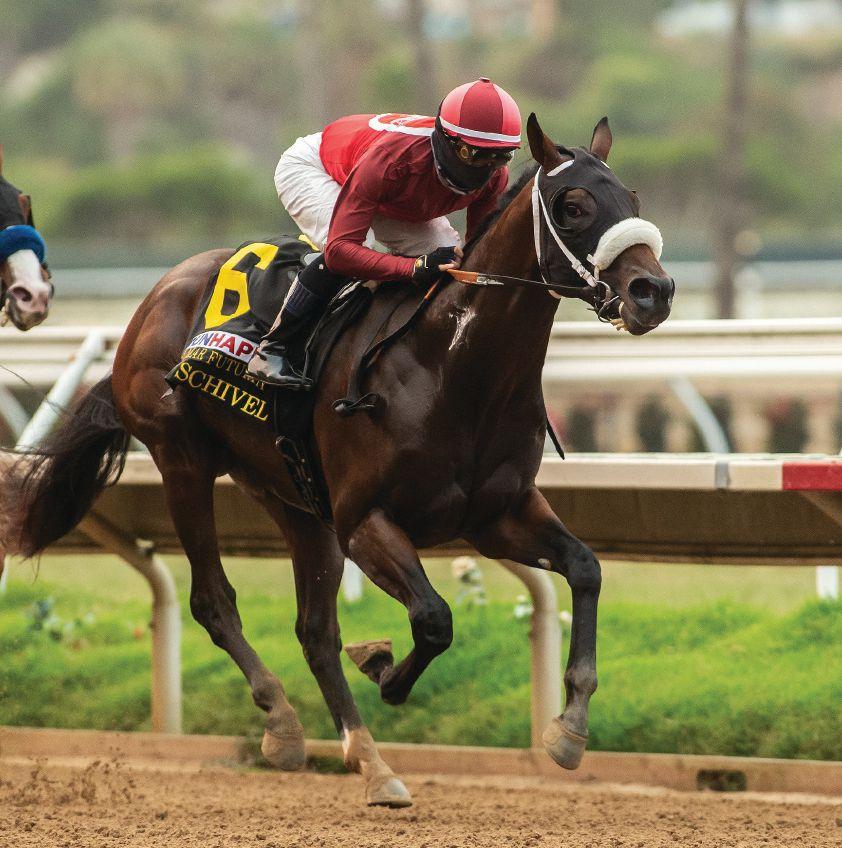
Call John Brocklebank at (801) 885-9969 or Call at or offce manager Randi Sackett at offce manager at (916) 496 6559 if you are interested in if you are interested in having your yearling broke and prepared having your yearling broke and prepared for success this year. for success this year. Email: redcliffsracing@gmail.comEmail: redcliffsracing@gmail.com
sory ligament, either at the back of the cannon bone (just below the hock) or even into the plantar ligament—since some of those fbers attach up into the plantar ligament at the back of the hock.
Some unusual aspects can sometimes be encountered with hock joint soreness.
In (weanlings and yearlings) we may see OCD or bone cysts in the hock joints. Tese defects are usually dicovered early on, and many are taken care of surgically. ”
— Dr. Duncan Peters
“Tere may be collateral ligament injuries,” said Peters. “Tese are interesting because the hock has two sets of collateral ligaments. One set is under tension during fexion, and the other set is under tension during extension of the hock joint. Occasionally, we see some ligament damage in one or the other set, depending on what kind of trauma occurred. Collateral ligament injury can certainly occur, but is not quite as common.”
Basically, the things that can happen to the hock joints in a young horse are osteochondral fragments (chips) in the upper tibial tarsal joint, infammation in any of the three joints for a variety of reasons (generally related to exercise), associated soreness of the proximal suspensory apparatus (as part of the functioning unit of the hock), and collateral ligament injuries. Some of these injuries might be due to the horse’s conformation, which can put more stress on certain parts of the joint, or just an occasional bad step.
MEDICAL MANAGEMENT
Dr. Mark Cassells of Homestead Veterinary Hospital in Villa Ridge, Mo., says that when he sees a hock problem in a fairly young horse, he looks at symmetry of the hock, making sure there isn’t joint distention on one side compared to the other.
“If there is some asymmetrical distenLegend and polyglycan.”
Your veterinarian can give advice on what to use. It might depend on the situation and whether the owner is comfortable giving shots or whether the horse will or won’t eat medication in the grain. What works
tion, this may mean there’s potential to fnd OCD (osteochondritis dessicans) fragments, joint chips, etc.,” Cassells said. “There is some debate as to whether these joint chips truly cause problems as the horses get older.”
Whether that chip causes problems may depend on whether it ever gets caught in the joint. If it’s embedded in the joint capsule and not foating around in the joint, it might not be a problem.
“I think the bigger problem is what that chip represents,” said Cassells. “If it’s due to a defect in the cartilage, this may be more

PHOTO CREDIT of an issue than the Radiograph showing a chip in a horse’s hock chip itself. With those horses, I usually try medical management frst, if they on one horse might not necessarily are having a problem. work on the next.
“The medical management “If the horse does not have a usually involves injection of the joint lameness issue, I try to manage it with regenerative therapies. I try to with systemic joint supplementaavoid corticosteroids in these hors- tion,” said Cassells. “If the horse es because the cartilage is already starts developing lameness issues, impaired. I think the regenerative then surgery becomes higher on therapies such as Pro-Stride, IRAP, my list of things to do, and medical stem cells, etc. are better than put- management with regenerative ting corticosteroids in these joints. therapies makes more sense than
“I am a big believer in some of steroids.” the supplemental systemic treat- If there is a questionable area on ments like Adequan or Pentosan. a hock that’s noted on radiographs, Anything we can do proactively Cassells suggests taking subsethat will reduce the likelihood of a quent radiographs over time, such problem due to joint infammation as every six months to a year. will be helpful. “This can show us any progression
“Cosequin is a feed-through of the condition, or lack of progression product that works well, as does of a disease condition,” he said. “If Platinum Performance CJ, for joint it is maintaining well and the horse is health. There are a number of performing well, then maybe nothing products that people use, including else needs to be changed.”
COURTESY OF MARK CASSELLS
2020 LEADING BREEDERS IN CALIFORNIA BY EARNINGS (THRU NOV. 15, 2020)
Breeder
Reddam Racing, LLC Nick Alexander Richard Barton Enterprises Harris Farms Terry C. Lovingier Tommy Town Thoroughbreds, LLC George Krikorian Mr. & Mrs. Larry D. Williams KMN Racing Dr. & Mrs. William T. Gray Liberty Road Stables Premier Thoroughbreds LLC Thomas W. Bachman C-Punch Ranch Inc. Old English Rancho Benjamin C. Warren Daehling Ranch LLC Gary Barber BG Stables Red Baron’s Barn LLC Alfred A. Pais George Schmitt & Mary Clare Schmitt Dr. Edward C. Allred Bar C Racing Stables, Inc. Madera Thoroughbreds Mark Devereaux, Scott Gross & Mark Gross Rozamund Barclay J. Kirk Robison & Judy Robison Terri Eaton & Joe Gibson Richard Barton Enterprises & Robert Traynor Victory Rose Thoroughbreds & KMN Racing Oakcrest Stable SLO Racing Stable Donald Valpredo BKB Stables LLC Martin Bach Andreas Psarras Pamela C. Ziebarth Victory Rose Thoroughbreds, Inc. Cole Ranch Rancho San Miguel Wachtel Stable & Gary Barber Ed Bernstein & Andrew Molasky Karen Headley DP Racing Legacy Ranch John Ernst & Allegra Ernst Old English Rancho/Berumen Curt & Lila Lanning Rusty & Debi Brown Templeton Horses, LLC Mick Ruis Hronis Racing, LLC Tom Halasz & Richard Brown Francis O’Leary Milt Policizer
Starts
324 345 709 310 550 394 135 203 56 204 217 111 146 129 140 19 165 78 135 42 26 230 46 18 137 22 180 12 37 54 40 32 40 107 49 30 68 65 138 57 53 13 12 18 76 93 46 106 65 39 4 20 17 11 73 52
Wins
56 64 74 45 57 65 19 34 10 33 22 13 15 21 28 4 15 17 18 9 8 22 8 6 25 4 10 5 9 11 5 7 8 8 8 6 11 9 15 12 12 1 4 5 7 9 4 7 5 10 3 2 3 4 7 4
Stakes Wins
1 2 0 3 1 1 4 2 4 1 0 1 0 0 0 4 1 0 0 2 0 0 3 3 0 1 1 2 0 0 1 0 0 0 2 2 0 0 0 0 0 0 0 1 0 0 0 0 0 0 2 0 0 0 0 0
Leading Earner
Make Happy ($319,458) Sadie Bluegrass ($114,880) Principe Carlo ($121,780) Fashionably Fast ($190,500) Time for Ebby ($93,278) Queen Bee to You ($120,000) Mucho Unusual ($257,333) Ward ‘n Jerry ($112,500) Sneaking Out ($260,110) Indian Peak ($143,940) Afternoon Heat ($81,660) Smiling Shirlee ($188,620) Take the One O One ($105,800) Rustic Canyon ($67,836) Table for Ten ($65,280) Warren’s Showtime ($412,980) Gotham Desire ($81,864) Give Me the Lute ($82,070) Violent Ridge ($49,246) Camino Del Paraiso ($187,090) Margot’s Boy ($171,480) Brave Cinderella ($33,695) Cordiality ($130,028) Galilean ($211,098) Happy Issue ($35,572) Tiger Dad ($147,972) Mo See Cal ($57,000) Good With People ($199,000) Draw Me ($120,192) A Melis ($87,880) Bulletproof One ($195,762) Songofthedesert ($84,046) Bella Chica ($67,760) Bako Sweets ($41,420) American Farmer ($90,458) El Tigre Terrible ($96,210) Tippy Top ($37,930) Bud Knight ($71,140) Secretly Paranoide ($25,610) Jet Set Ruler ($42,000) Misirlou ($49,980) California Kook ($162,860) On Mars ($161,520) Tee Em Eye ($111,021) Silk From Heaven ($62,480) Gypsy Blu ($38,070) Sassyserb ($86,672) He Will ($31,095) Eustace ($54,980) Friday At Shady ($43,908) Governor Goteven ($153,000) Sedamar ($100,618) Brix ($89,040) Sheza Girly Girl ($146,426) Night Gig ($26,460) Adorably Sweet ($34,700)
Earnings
$2,234,816 $1,619,489 $1,591,601 $1,261,233 $1,186,001 $1,081,598 $933,579 $772,177 $732,243 $705,245 $595,665 $590,729 $465,404 $451,687 $447,668 $421,012 $385,081 $359,961 $351,773 $350,336 $345,548 $309,530 $271,766 $268,291 $268,232 $257,878 $252,181 $242,600 $236,332 $234,620 $231,615 $220,076 $216,872 $213,488 $199,319 $198,094 $190,537 $184,062 $183,640 $182,094 $181,052 $172,816 $170,360 $170,141 $169,759 $166,097 $164,032 $163,765 $163,583 $160,528 $153,000 $151,668 $149,700 $146,426 $146,303 $145,960


